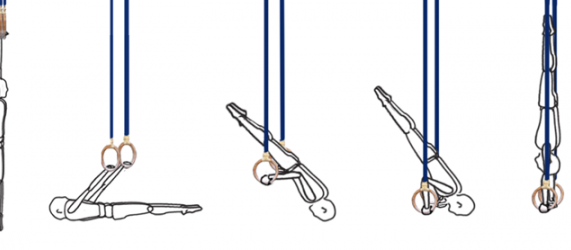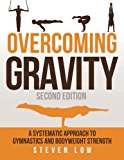The Second Edition of Overcoming Gravity has been released on Amazon! This is one of the articles that I wrote in response to the First Edition of the book, and more detail is included about this topic in the Second Edition. I’ve worked on overhauling this article to give you a good base on which to construct a strength oriented bodyweight routine to work toward your goals. If you are interested in learning more, check out the book.
I’ve also created a 12-hour YouTube series called Overcoming Gravity Online which goes over the concepts from this article and the book in greater depth. If you have the book it’s mean to be a supplement to the book, but an great intro to the topic if you don’t have it either. Link to the playlist.
It has been brought to my attention that some people newer to training may find the level of detail in the First Edition of Overcoming Gravity to be too much to handle at first. Therefore, I’m writing this brief article on how the book should be approached if you are having trouble with the volume of information.
The Second Edition of Overcoming Gravity discusses most of the details of this article in the book itself. However, this article will serve as a solid reminder, if you are confused about particular issues.
Table of contents
- What you need to know as a newbie
- How to construct a workout routine
- Types of exercises on the charts
- Categorization of horizontal and vertical aspects of pushing and pulling
- Skill work
- Paralysis by analysis
What you need to know as a newbie
I put the chapter summaries into the book because I am a huge fan of them in lots of other books. Most of the salient points that I wanted you to learn in each chapter are located in each chapter summary.
Therefore, if the level of detail was too high or confusing in some of the chapters, just ignore the chapter itself and focus on the chapter summary.
These are the concepts that I need you to learn to help you effectively construct a routine. The small other details may be useful as you become more familiar with the material.
How to construct a workout routine
The most important points in each chapter to learn how to construct a routine are in the bolded Stop sections at the end of each chapter right before the chapter summary.
Thus, if you want to know “how” construct a routine right away without reading any of the details on the “why”, “when”, etc. then skip to each Stop section in the first ~3-9 Chapters.
The sample programming in Part 4 and beyond will also be a good “quick start” to compare your initial programming/routine with how I would make one for each of the levels.
If you are still having issues, check out The Fundamentals of Bodyweight Strength Training which is the article on which the book is based.
Types of exercises on the charts
Each chart contains exercises which are categorized thusly,
- chart #1 – handstand oriented which is a push generally
- chart #2 – front lever, back lever, rows, cross, etc. which are pulling oriented
- chart #3 – planche, dips, pushups which are push oriented
- chart #4 – muscle ups, and other skill types which are combined or vary
Categorization of horizontal and vertical aspects of pushing and pulling
There has been some confusion about how to categorize exercises according to their type. This expounds on the previous question about the type of exercises each chart contains.
Just think about the direction of the force your hands are going – if it’s going up or down it’s vertical. If it’s going horizontal then it’s horizontal.
Therefore,
- Vertical pulling – pullups, inverted pullups, etc.
- Horizontal pulling – Front lever, back lever, rows, etc.
- Vertical pushing – HSPUs, dips, etc
- Horizontal pushing – Pushups, planche, etc
Skill work
There was a good discussion on reddit about skill work. I’ll post some of the clarifications here.
In general, “skill work” in any sport is anything that you need to practice a lot to improve your sports specific skills.
For most gymnastics based skills, this is going to be more along the lines of any type of balance skills that need a lot of practice — handstands, elbow levers, and more in the context of movement type exercises such as swings, tumbling, rolling, flips, etc.
“Strength” isometrics like planche, front lever, back lever are NOT skill work. I said in sample programming section that they can be used as warm up if you drop down the 2-3 levels of ability. However, since once you can do say a straddle planche, you don’t actually have to practice tuck planche much to be good at it then I wouldn’t actually consider it skill work in the strictest sense of the word. You can use decreased levels for warm up, but not skill work. Make sense?
I wrote about this a bit more on page 247:
The key behind all skill work is the fact that the more you practice at something the faster you will get better at it. However, too much practice with skills even as simple as handstands can impair recovery. There needs to be balance (no pun intended) to facilitate optimal improvement.
How we hit this balance is a tough question to consider. For most people, simply getting upside down in a handstand is a hard feat. For those more experienced who can hold a freestanding handstand longer than a minute, 10 minutes of total work would not be a stretch of the imagination.
I think the best way to approach skill work is like the warm up. It should not leave you excessively tired or sweaty to start performing your strength workouts. This may be only 20 seconds inverted for new people but maybe even 15-20 minutes for more experienced people trying to learn advanced skills like one arm handstand. You are aiming to get the greatest quality of work without fatiguing yourself such that
your technique is going to deteriorate.I hope that gives you a better idea of the times you are aiming at. It does not have be a set time such as five minutes upside down six-seven days a week. I would play it more by feel. Aim for quality work and quit if the skill work is deteriorating or you are having a bad day. There is no shame in knowing that you cannot do something every day; we all have off days where nothing goes right.
One of the ways that someone told me they were going to implement their handstand skill work is to use the isometric prilepin’s tables that I construct. That is definitely one good way to limit fatigue, especially if you’re new to a skill and you can only do it for a max set amount of time.
However, sets, rest times, etc. pretty much depend on when you feel you are sufficiently recovered to do good quality work. As you get stronger and more conditioned, the rest times between skill work sets will decrease which is why I hesitate saying wait 3-5 minutes like I would say with typical strength work or along those lines.
For example, for say an allotted 15 minutes of “handstand” work before you get to your routine, as a beginner you might only spend about 3 minutes inverted because it’s fatiguing to be upside down that much. But once you get to a higher level you may be holding sets of 30s+ of handstands and be able to work at least 10 of those sets. So you may be inverted 5 minutes of that time total. As you get better, you may be inverted 7+ of those minutes. So it depends.
Since skill work and handstands are so important to an effective bodyweight fitness routine, I am a proponent of Chris’ The 15-Second Handstand: A Beginner’s Guide. It supplements Overcoming Gravity’s Handstand section by focusing on getting you upside down ASAP with a step-by-step explanation of everything. Programs like this help you to drill the skill, make progress and learn what skill training is all about straight away.
Paralysis by analysis
If you are having “paralysis by analysis” trying to get everything perfect or trying to fit everything in or are still confused with programming I want you to take a step back and take a few deep breaths.
The aim of Overcoming Gravity is to teach you how to construct an effective and safe routine to work towards your goals. The book is here to guide you through that process. You will get better as you practice more. However, you can really only learn by doing and making some mistakes.
Construct a routine. It does not matter if it’s perfect or not. As long as it fits your goals and is structurally balanced it will be a good place to start.
If you are still concerned and want some feedback, feel free to post your goals, current abilities, and proposed new routine on our Overcoming Gravity reddit for critique.
Please do not spend weeks trying to figure out something perfect. It’s a waste of valuable training and learning time. Physical activity is not something we can be perfect in at the beginning when we start unlike book knowledge.
Feel free to ask any other questions or comments about the book to the Overcoming Gravity reddit.
If you want constructive feedback on your particular routine make sure to include:
- Your goals
- Height & weight
- Current max abilities
- Proposed routine
- Any other specific questions you may have
Thanks for your support, and don’t forget to submit an Amazon review.
If you have the First Edition, check out some of the details of the Second Edition as it is vastly expanded and corrects many of the errors of the First Edition. Here is the book detail page.
This article was originally published February 7th, 2012 on Eat Move Improve. Updated Feb 2017.
Questions about articles may be addressed to the Overcoming Gravity reddit.
Author: Steven Low
Steven Low is the author of Overcoming Gravity: A Systematic Approach to Gymnastics and Bodyweight Strength (Second Edition), Overcoming Poor Posture, Overcoming Tendonitis, and Overcoming Gravity Advanced Programming. He is a former gymnast who has performed with and coached the exhibitional gymnastics troupe, Gymkana. Steven has a Bachelor of Science in Biochemistry from the University of Maryland College Park, and his Doctorate of Physical Therapy from the University of Maryland Baltimore. Steven is a Senior trainer for Dragon Door’s Progressive Calisthenics Certification (PCC). He has also spent thousands of hours independently researching the scientific foundations of health, fitness and nutrition and is able to provide many insights into practical care for injuries. His training is varied and intense with a focus on gymnastics, parkour, rock climbing, and sprinting. Digital copies of the books are available in the store.

